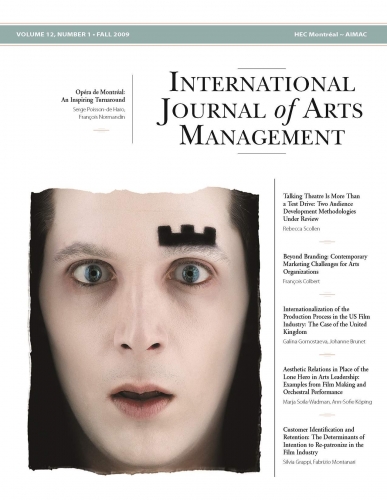Customer Identification and Retention: The Determinants of Intention to Re-patronize in the Film Industry
Produit: Article
21,00 $ CA
Silvia Grappi, Fabrizio Montanari
Silvia Grappi is an assistant professor at the University of Modena and Reggio Emilia in Italy. Her research interests include issues related to branding and consumer behaviour.
Fabrizio Montanari is an assistant professor at the University of Modena and Reggio Emilia and at ASK Bocconi University. He is the Scientific Coordinator of OPERA, a research unit specializing in the cultural industries and social media. His main research interest is the analysis of networks and teams in the cultural industries.
ABSTRACT
The film industry is characterized by competitiveness, and now cinema owners are facing an increased level of competition owing partly to the spread of multiplex theatres. One of the main concerns of cinema owners is how to devise effective strategies for increasing customer retention. The purpose of this study is to demonstrate the role that a customer’s identification with a cinema and its usual patrons might play in his/her intention to re-patronize that cinema. The researchers draw on the theory of planned behaviour, considering also the influence of customer perceived value and satisfaction in predicting re-patronizing intention. They collected 201 questionnaires from a sample of moviegoers at Anteo Saziocinema, a well-reputed multi-screen cinema in Milan, Italy. They analyze the data using a structural equation model. The results confirm the important role of customer identification in explaining intention to re-patronize a cinema.
KEYWORDS
Film industry, re-patronizing behaviour, customer identification, structural equation model
RÉSUMÉ
L’industrie du film est caractérisée par la concurrence et, de nos jours, les propriétaires de cinémas font face à une concurrence accrue due, en partie, à la multiplication des multiplexes. Une de leurs principales préoccupations est de concevoir des stratégies efficaces pour fidéliser leur clientèle. L’étude a pour but de montrer le rôle que peut jouer l’identification du client à un cinéma et à sa clientèle régulière dans l’intention de fréquenter à nouveau ce cinéma. Les chercheurs fondent leurs analyses sur la théorie du comportement prévu, considérant aussi l’influence de la valeur perçue et de la satisfaction pour prédire l’intention de fréquentation répétée. Ils analysent 201 questionnaires, remplis par un échantillon de clients du Anteo Saziocinema, à l’aide du modèle d’équations structurelles. Les résultats confirment l’importance de l’identification du client pour expliquer l’intention de fréquenter à nouveau un cinéma.
MOTS CLÉS
Industrie cinématographique, fréquentation répétée, capacité d’identification du client, modèle d’équations structurelles
RESUMEN
La industria cinematográfica se caracteriza por su competitividad y los propietarios de cines, al enfrentarse hoy día a un entorno cada vez más competitivo debido en parte a la expansión de las salas múltiplex, se interesan en particular en diseñar estrategias eficaces para aumentar el número de clientes y conservarlos. El presente estudio tiene como propósito demostrar el papel que desempeña la identificación por parte de la clientela con un cine en particular en su intención de volver a frecuentarlo. Los investigadores se apoyan en la teoría del comportamiento determinado por un objetivo, tomando también en cuenta el valor que la clientela percibe y su nivel de satisfacción, para predecir su intención de volver a frecuentar un cine. Se recogieron 201 cuestionarios de una muestra de cinéfilos del Anteo Saziocinema, un cine de pantallas múltiples que goza de buena reputación en Milano, Italia. Analizaron los datos utilizando un modelo de ecuación estructural. Los resultados confirman el papel importante de la identificación de la clientela para explicar su intención de volver a frecuentar un cine en particular.
PALABRAS CLAVE
Industria cinematográfica, volver a frecuentar, identificación de la clientela, modelo de ecuación estructural

